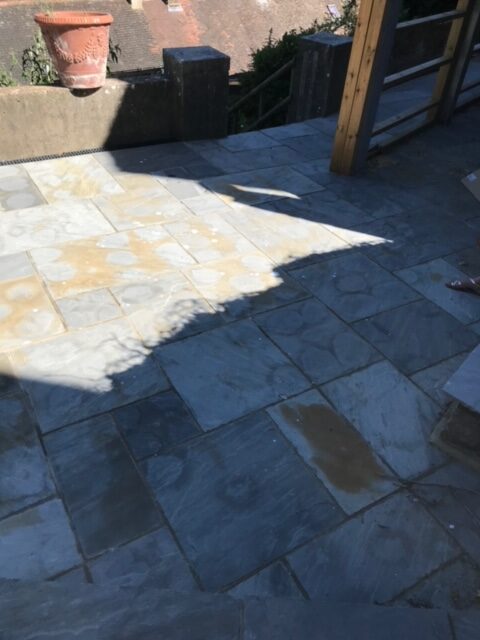
Outdoors
REFLECTIVE STAINING
A Guide for Professionals
INTRODUCTION
Reflective staining is a phenomenon most commonly seen on Natural Stone Paving materials, but can also be seen occasually with man made concrete paving slabs. When these slabs are incorrectly laid on spots, dabs (5 spot method) or rings of mortar, Reflective Staining appears on the surface of the paving material as a distinctive pattern of marks (stains) usually as rings or circles, these reflect the shape of the incomplete mortar bed underneath the paving material, hence the name ‘Reflective Staining’.
This problem is solely the responsibility of the contractor who incorrectly installed the paving material to resolve, its is not a fault with the product, bedding material or ground conditions, its is incorrect installation and no matter what anyone says the sole responsibility of this lies with the person responsible for its installation !

Please see slabs laid on small mortar spots, transferring to the surface of the natural stone paving.
The appearance of the staining
In most cases these stains appear as ring or circle on the surface of the paving slabs, they usually are darker in colour to the paving material and can have hard white chalky deposit left on the surface of the stone after long periods of time. These stains can also be further emphasised by salts being transfer to the surface through these stained areas through natural process of efflorescence, as well as build up of algae growth which can make the stains more visible due to the contrasting colours between the stains and the algae deposits.
Cause of Reflective Staining
Reflective staining is caused by paving slabs being installed using spots, dabs (5 spot method) or rings of mortar, the salts and minerals emanating from the mortar are carried through the capillaries to the surface. As the bedding material is not evenly distributed across the whole of the underside of the stone, the moisture and salt deposits are very concentrated into small areas where mortar is present, greatly enhancing the discolouration. When the salts and minerals reach the surface of the paving they can crystallise and chemically bond with the substrate, in this case your paving slabs. This creates a chemically hardened stain that is bounded to the paving as is no longer removable.
In some case you might not develop a build up of staining on the surface of the stone, you will just have damp patches present on the surface after wet weather, this is caused by the same installation problem, as the moisture is being transferred to the surface of the paving through the unevenly distributed bedding material, and the surface of the stone will dry at different rates due to the varying levels of moisture.
This problem also seems to be accentuated when the paving is being laid on a site with wetter ground conditions, such as clay soils. this tends to mean the process happens quicker and more severely than on well drained sites.
Possible Solutions
Reflective staining occurs when paving products have been incorrectly laid, if your find yourself in this situation there is practically nothing you can do to remove this problem. Im some cases where algae or salt build up has made the problem more obvious a good quality outdoor cleaner such as New Clean 60, link blow, can help a little to improve the appearance, but is no way a fix.
Sometimes the passing of time will help lessen the severity of the problems, as the staining can fade slightly, but it is very unlikely that the problem will totally go away and you might just be moving the problem down the road a few months or years.
The only real solution
To be totally honest the only solution if you have this problem is to lift the slabs, dispose of them and replace them with new and re-install then, this time correctly.
All paving materials must be laid to British Standard 7533: Part 4 , which covers the installation of both concrete and natural stone paving materials, this standard requires that all paving is laid on a “full bedding layer”.
When paving is laid correctly on a full mortar bed, the whole of the underside of the paving slab is in direct contact with the bedding material, so there is a more even porosity of the stone and bedding materials across the whole of the installation. This even porosity allows for moisture and salt deposits to be much more evenly deposited across the whole surface of the paving making any build ups, much more difficult or impossible to identify, as the paving would present a homogenous surface appearance.
We would also recommend that a Prime such as ProPrime link below, is used on all paving installation, this will help create a barrier between the paving and the bedding material, reducing the transfer of moisture and salts to the surface of the stone, as well has help them bond well together improving the longevity of the installation.
If you are working on poorly draining soils, you will need to use a much larger sub-base or install land drainage under the paving area to insure water does not sit for long periods of time under the paving installation. This will greatly reduce any possibility of water transferring from the bedding materials to the surface of the stone helping to greatly reduce any chances of reflective staining.
NATURAL STONE AND TIMBER LTD WILL NOT TAKE ANY RESPONSIBILITY FOR PROBLEMS CAUSED IF PRODUCTS ARE INSTALLED OR TREATED INCORRECTLY.
IF YOU NEED ANY ADVICE PLEASE CONTACT A MEMBER OF STAFF AT YOUR LOCAL DEPOT, ON ONE OF THE NUMBERS BELOW, WHO WILL BE HAPPY TO ADVISE YOU ON ANY OF OUR PRODUCTS.

